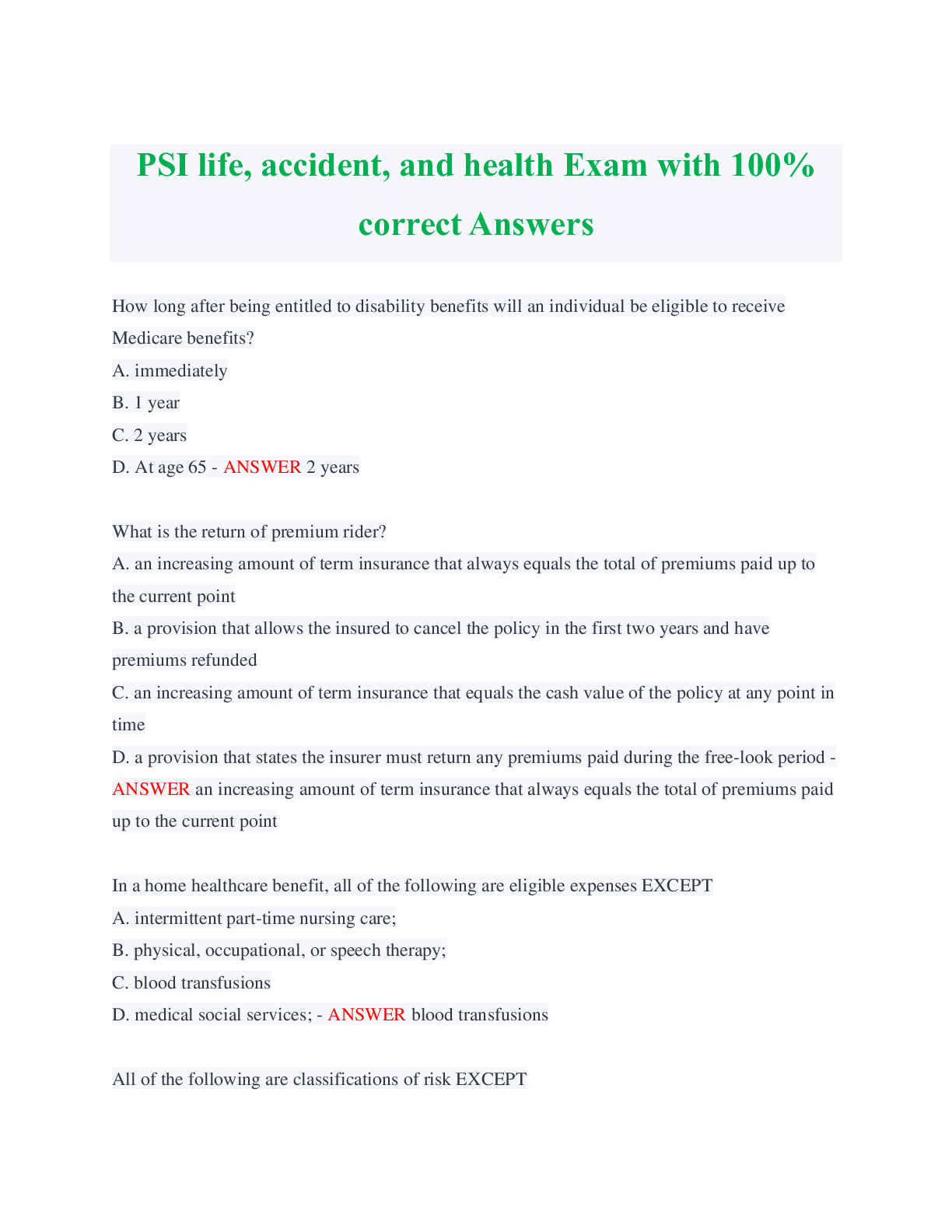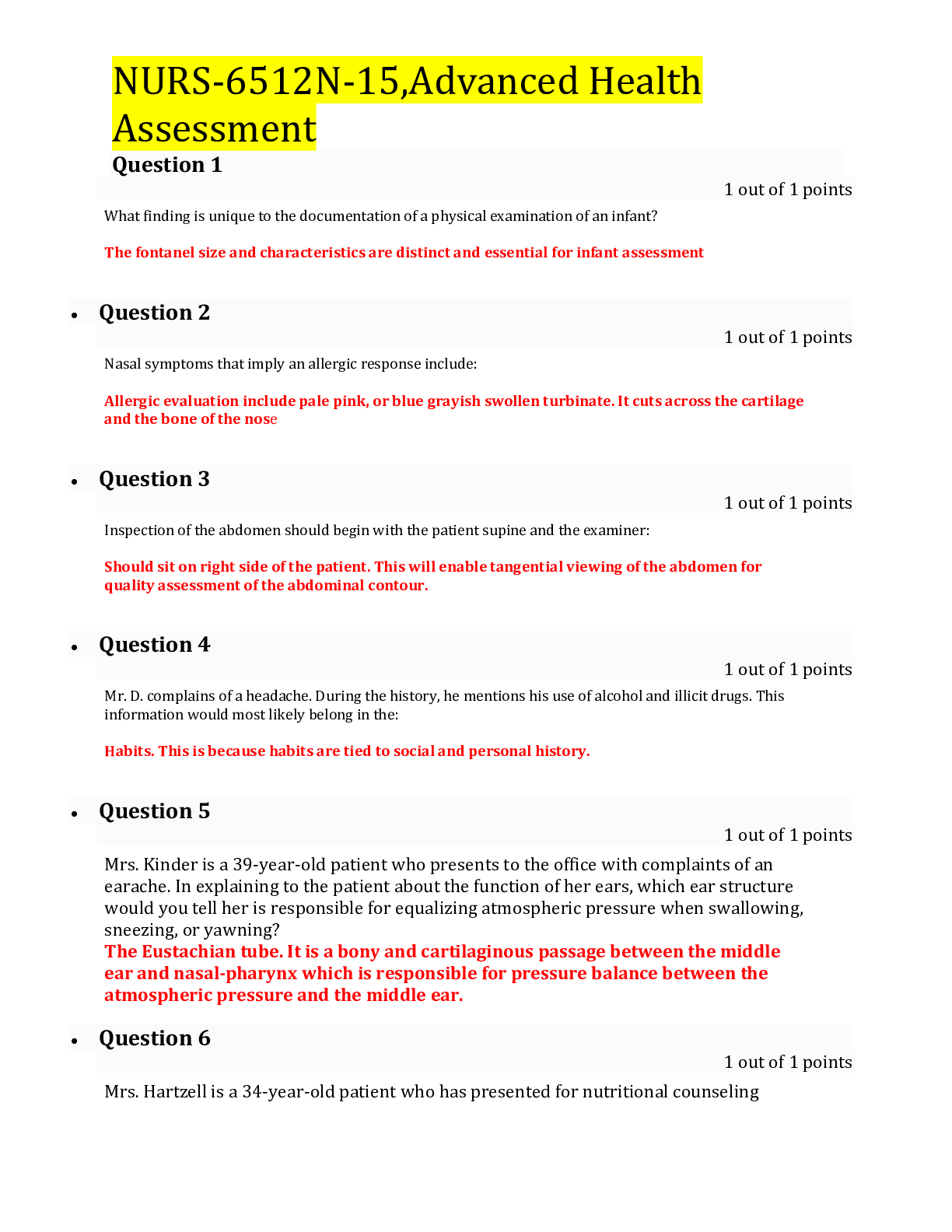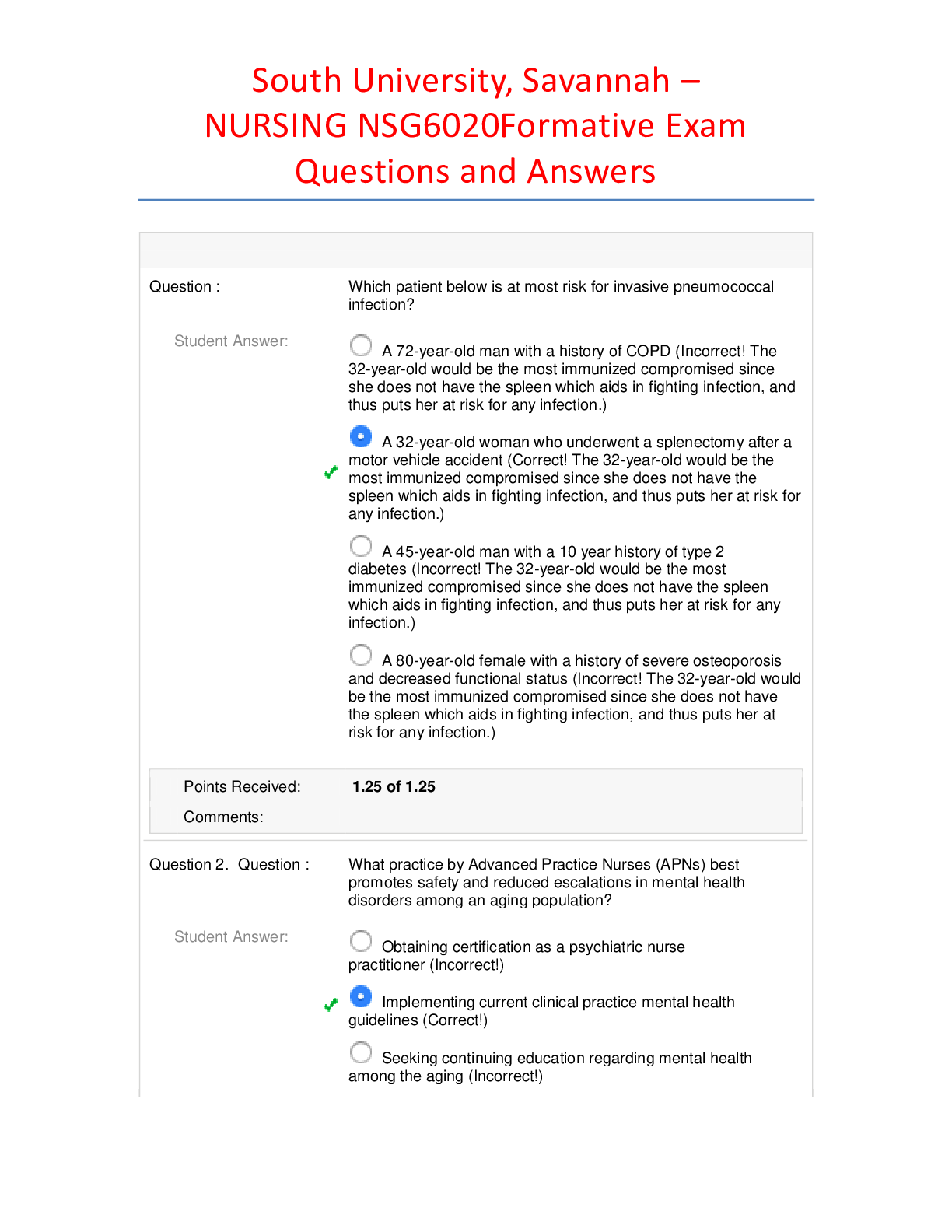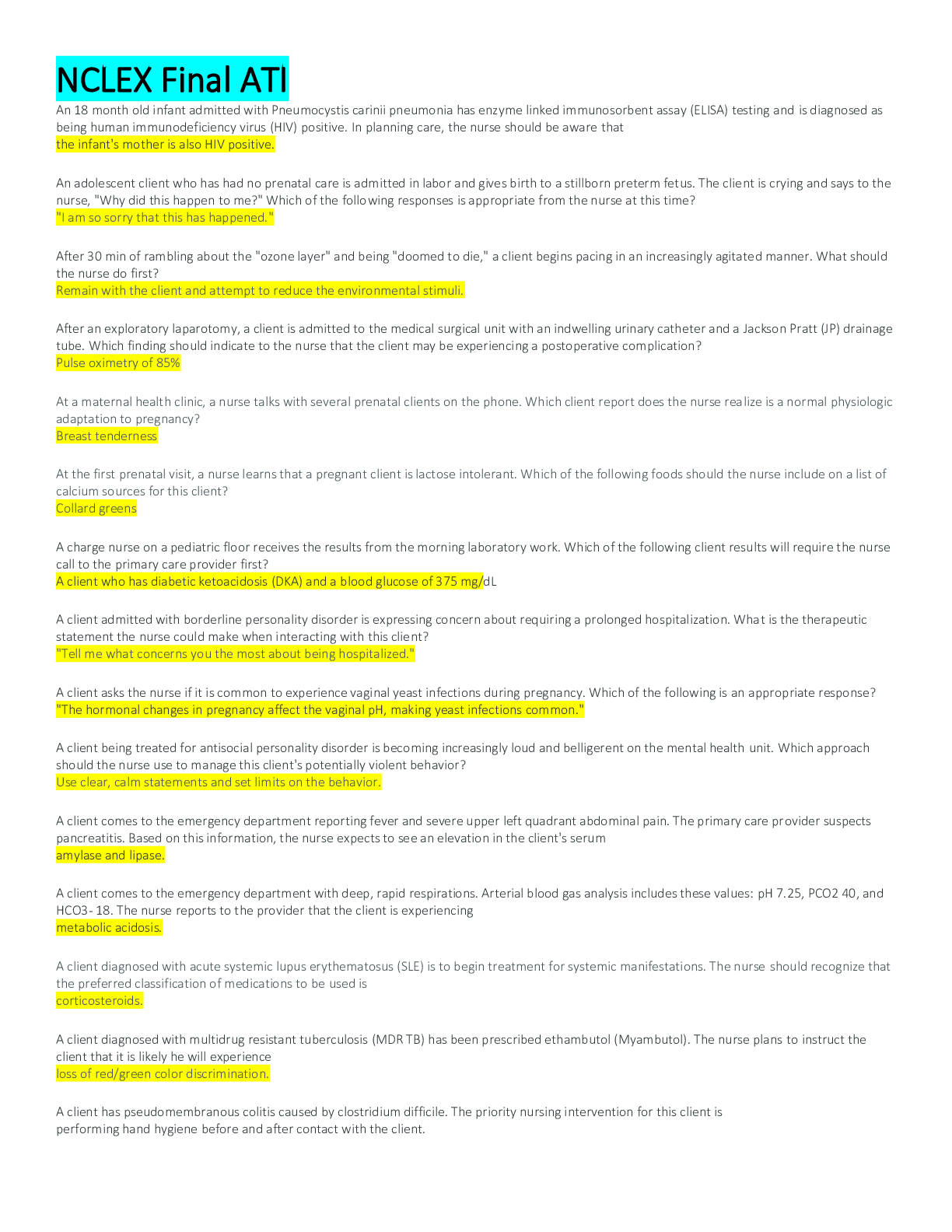Health Care > EXAM > WGU-C805 Pathophysiology Exam Questions and Answers (All)
WGU-C805 Pathophysiology Exam Questions and Answers
Document Content and Description Below
30 minutes or longer ANSWER-Lucile calls your medical clinic asking to speak with the nurse. You are an LPN who takes the call. Lucile is asking how long angina pain should last before she becomes ala... rmed. What will you tell her? A heart attack signals blockage of blood flow to a part of the heart muscle; cardiac arrest is sudden loss of heartbeat, pulse, and respiration. ANSWER-How might you compare/contrast a heart attack with cardiac arrest to a friend who is confused about the difference? Abdominal, thoracic, and peripheral ANSWER-The three common types of aneurysms. AIDS ANSWER-_________ occurs as a result of HIV infection, usually after approximately 6 to 9 years of infection. It is a syndrome of a constellation of infections, conditions, or malignancies that occur as a result of the increasing immune depletion that HIV infection incurs over time. An ECG, stress test, CT scan, and an MRA ANSWER-When CAD is suspected, what diagnostic tools might help in making a diagnosis? Andographis and probiotics ANSWER-Blaine just gets over one cold and gets another. He feels miserable, but there is no antibiotic for it. An Internet search suggests some complementary therapies that might help. What are they? Aneurysm ANSWER-What is it called when there is a local dilation of an artery or chamber of the heart due to weakening of its walls? Treatments for leukemias ANSWER-Any therapies to reduce effects of chemotherapy Aplastic anemia ANSWER-What is the possible cause of low reticulocyte counts in blood tests? Atherosclerosis ANSWER-What is the name of the condition characterized by accumulation of yellowish plaques of cholesterol, lipids, and cellular debris in the inner layers of large- and medium-sized arteries? Atherosclerosis ANSWER-Marked by cholesterol-lipid-calcium deposits in the walls of arteries that may restrict blood flow. Arteriosclerosis ANSWER-A disease of the arterial vessels marked by thickening and loss of elasticity in the arterial walls. It is known colloquially as "hardening of the arteries." Automated External Defibrillators (AEDs) ANSWER-Instruments programmed to give an electric shock only when necessary; can be used by anyone. Atrial fibrillation ANSWER-The two atria in the heart beat irregularly, often quite rapidly, and out of rhythm with the lower ventricles. Bacteremia ANSWER-What is the term for bacteria in the blood that travels throughout the body causing serious consequences? Bleeding under the skin and from the mouth, eyes, and ears ANSWER-Margery is a missionary nurse in the West African country of Guinea. She is very much aware of the threat of hemorrhagic fevers and continually teaches to be watchful for a very specific set of symptoms. What are they? Mitral valve insuffieciency ANSWER-Blood backflows into the left atrium. Botulism ANSWER-_________ is a serious disease that paralyzes muscles. The symptoms usually occur within 12 to 36 hours of eating contaminated food and include blurred or double vision, slurred speech, drooping eyelids, difficulty swallowing, and muscle weakness. Symptoms can appear, however, as early as 6 hours and as late as 10 days from exposure. The muscle weakness moves through the body, paralyzing arms and legs. Death may occur when respiratory muscles become paralyzed. Botulism was injected into hand grenades tossed at the soldiers. ANSWER-Charles is a World War II survivor. He was in the army and saw a fair amount of battle. He tells you that his greatest fear was from botulism poisoning. How is that possible? Bruit ANSWER-Abnormal heart sound heard on auscultation Cardiac tamponade ANSWER-Fluid in pericardium compresses the heart Cardioversion ANSWER-Reset hearts rhythm to normal sinus Catarrhal stage, approximately 7 to 10 days ANSWER-Casey has pertussis. His mother is contacting his friends to tell them they may have been exposed. At what stage and period of time is this? Category A of potential weapons ANSWER-Easily transmitted from person to person Infectious diarrheal outbreaks ANSWER-Caused by rotaviruses, bacteria, and parasites; maybe airborne respiratory droplets. Cellulitis ANSWER-Inflammation of connective tissue Chronic fatigue syndrome ANSWER-Karen is exhausted all the time, has a chronic sore throat and myalgia, does not sleep well, and feels like she is in a fog all the time. What might her PCP consider? Concussion ANSWER-An injury resulting from impact with an object. Partial or complete loss of function, as that resulting from a blow or fall. Contusion ANSWER-An injury where the tissue along or just beneath the surface of the brain is bruised. Crushing chest pain radiating to the left arm, neck, and jaw ANSWER-What is the "classic" symptom of myocardial infarction? Cutaneous anthrax ANSWER-A cattle rancher in western Nebraska can be concerned about what kind of anthrax that farmers and ranchers are regularly exposed to? Dilatation ANSWER-Expansion of an organ or vessel Diphtheria ANSWER-What is the name of the acute, life-threatening infectious disease characterized by a membrane-like coating that forms over mucous membrane surfaces, especially the respiratory tract? Discomfort, nausea, shortness of breath, indigestion, and fatigue ANSWER-You are quite aware of the symptoms of an MI for men, but what kind of symptoms might women have? DTaP vaccine ANSWER-Prevention from diphtheria Dyspnea ANSWER-Difficulty breathing Effusion ANSWER-An escape of fluid Endocarditis ANSWER-When there is an inflammation with abnormal vegetations in the membrane lining the heart valves, what is the disease called? Erythema chronicum migrans (ECM) rash ANSWER-How is stage 1 of Lyme disease typically described? Erythemia infectiosum (fifth disease) ANSWER-Causes a "slapped cheeck" rash FAST ANSWER-Face, Arms, Speech, Time Arenaviruses, Filoviruses, Bunyaviruses, and Flaviviruses ANSWER-Viral hemorrhagic fevers (VHFs) are a group of viral illnesses that affect multiple organ systems in the body. The four main groups of the viruses are __________. Viral hemorrhagic fevers ANSWER-A group of viral illnesses that affect multiple organ systems in the body. The body's vascular system is damaged, and the body is unable to regulate itself. These agents are highly infectious and very stable via the aerosol route, which makes them potential bioterrorism weapons. For protection from any bacterial infection from the procedures, antibiotic therapy should begin prior to the procedures. ANSWER-Gerald has a pacemaker and needs to have dental work, including a root canal and a crown. Are there any precautions that Gerald should take? Get vaccinated with DTaP and get boosters. ANSWER-What are some methods to prevent tetanus? Given at 12 to 15 months of age; again at age 6 to prevent disease ANSWER-MMRV vaccine Greater and lesser saphenous veins ANSWER-Where are varicose veins most likely to occur? Hematoma ANSWER-A swelling comprising a mass of extravasated blood (usually clotted) confined to an organ, tissue, or space and caused by a break in a blood vessel. Hematopoietic ANSWER-Tissue related to the blood cells in bone marrow Hemolytic uremic syndrome ANSWER-Adam, age 6, has been hospitalized with a serious case of infection from E. coli O157:H7. Medical professionals are hoping to prevent which potentially life-threatening complication? Hemorrhagic stroke ANSWER-Cause can be hypertension, aneurysm, head injury, arteriovenous malfunction, or blood disease. Hemorrhagic stroke ANSWER-Occurs when a blood vessel on the brain's surface ruptures and bleeds into just the subarachnoid space or when the blood floods the brain itself. High-fat diet, distress, obesity, no exercise, and smoking ANSWER-Can you identify characteristics, largely preventable, that may make a person more susceptible to cardiovascular diseases? His particular infection is not a threat to others. ANSWER-If Cary is being treated for an infection, why is he still going to work and meeting friends? HIV ANSWER-Caused by a retrovirus that infects and replicates in human lymphocytes and macrophages, eroding the integrity of the human immune system over a number of years. Most people are infected through sexual contact, before birth or during delivery, during breast-feeding, or when sharing contaminated needles and syringes. ANSWER- Hodgkin lymphoma ANSWER-What is the name for a neoplastic malignancy of the lymphatic system characterized by painless enlargement of the lymph nodes and spleen? Holter monitor ANSWER-Dr. Trang was unable to confirm her diagnosis of a client with myocarditis with an ECG. What might she order to get a clearer picture of the abnormalities? Idiopathic ANSWER-Of unknown cause Injections of vitamin B12 ANSWER-What is the initial treatment of pernicious anemia? Iron-deficiency anemia due to inadequate reserves of iron in the body ANSWER-Lucile is working in the lab examining blood cells in the microscope. She is seeing many unusually small, hemoglobin-poor RBCs that are lighter in color than usual. What might she be viewing? It has DNA typical to avian, swine, and human viruses. ANSWER-What is the peculiar nature of the H1N1 virus? H1N1 flu ANSWER-This virus is caused by a never-before-seen mixture of viruses typical among pigs, birds, and humans. It spreads much like pneumonic plague. ANSWER-What makes SARS so infectious? Lacteal ANSWER-Capillaries in the villus of the small intestine Lyme disease ANSWER-The disease caused by a tiny tick-transmitted spirochete is called _______. Lymphangitis ANSWER-Inflammation of the lymph vessels Lymphedema ANSWER-What is an abnormal accumulation of lymph, usually in the extremities, called? Megakaryocyte ANSWER-Large bone marrow cell with multiple nuclei Microbial adaptation and change ANSWER-Which of the following are among the many factors responsible for the surge in new infectious and communicable diseases? Mumps ANSWER-Which of the following has the classic symptom of swollen parotid glands? Myalgia ANSWER-Muscle ache Overuse of antibiotics has created antimicrobial resistance. ANSWER-Many infectious diseases are increasingly difficult to treat because of what problem? Pericarditis ANSWER-Nadine had rheumatic fever as a child. Now in her 60s, Nadine is showing signs of sharp pleuritic pain that increases when she takes deep breaths, and she says her heart is "racing." What condition might she be experiencing? Petechiae ANSWER-Pinpoint hemorrhagic spots on the skin Poor; generally a survival of only 1 year after diagnosis ANSWER-Keith has been diagnosed with AML; he is 74 and suffers from diabetes and hypertension. What might his prognosis be? Reticulocyte ANSWER-Immature form of RBCs [Show More]
Last updated: 2 years ago
Preview 1 out of 50 pages

Buy this document to get the full access instantly
Instant Download Access after purchase
Buy NowInstant download
We Accept:

Reviews( 0 )
$10.00
Can't find what you want? Try our AI powered Search
Document information
Connected school, study & course
About the document
Uploaded On
Oct 21, 2022
Number of pages
50
Written in
Additional information
This document has been written for:
Uploaded
Oct 21, 2022
Downloads
0
Views
175
























.png)

